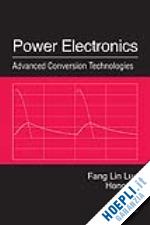
Questo prodotto usufruisce delle SPEDIZIONI GRATIS
selezionando l'opzione Corriere Veloce in fase di ordine.
Pagabile anche con Carta della cultura giovani e del merito, 18App Bonus Cultura e Carta del Docente
The ever-growing shortage of energy resources continues to make the development of renewable energy sources, energy-saving techniques, and power supply quality an increasingly critical issue. To meet the need to develop renewable and energy-saving power sources, green energy source systems require large numbers of converters. New converters, such as the Vienna rectifier and z-source inverters, are designed to improve the power factor and increase power efficiency.
Power Electronics: Advanced Conversion Technologies gives those working in power electronics useful and concise information regarding advanced converters. Offering methods for determining accurate solutions in the design of converters for industrial applications, this book details more than 200 topologies concerning advanced converters that the authors themselves have developed. The text analyzes new converter circuits that have not been widely examined, and it covers the rapid advances in the field, presenting ways to solve and correct the historical problems associated with them.
The technology of DC/DC conversion is making rapid progress. It is estimated that more than 600 topologies of DC/DC converters exist, and new ones are being created every year. The authors completed the mammoth task of systematically sorting and categorizing the DC/DC converters into six groups and have made major contributions to voltage-lift and super-lift techniques. Detailing the authors’ work, this book investigates topics including
With many examples and homework problems to help the reader thoroughly understand design and application of power electronics, this volume can be used both as a textbook for university students studying power electronics and a reference book for practicing engineers.
Introduction
Symbols and Factors Used in This Book
AC/DC Rectifiers
DC/DC Converters
DC/AC Inverters
AC/AC Converters
AC/DC/AC and DC/AC/DC Converters
Uncontrolled AC/DC Converters
Single-Phase Half-Wave Converters
Single-Phase Full-Wave Converters
Three-Phase Half-Wave Converters
Six-Phase Half-Wave Converters
Three-Phase Full-Wave Converters
Multiphase Full-Wave Converters
Controlled AC/DC Converters
Single-Phase Half-Wave Controlled Converters
Single-Phase Full-Wave Controlled Converters
Three-Phase Half-Wave Controlled Rectifiers
Six-Phase Half-Wave Controlled Rectifiers
Three-Phase Full-Wave Controlled Converters
Multiphase Full-Wave Controlled Converters
Implementing Power Factor Correction in AC/DC Converters
DC/DC Converterized Rectifiers
PWM Boost-Type Rectifiers
Tapped-Transformer Converters
Single-Stage PFC AC/DC Converters
VIENNA Rectifiers
Ordinary DC/DC Converters
Fundamental Converters
P/O Buck-Boost Converter
Transformer-Type Converters
Developed Converters
Tapped-Inductor Converters
Voltage Lift Converters
Seven Self-Lift Converters
P/O Luo-Converters
N/O Luo-Converters
Modified P/O Luo-Converters
D/O Luo-Converters
VL Cúk-Converters
VL SEPICs
Other D/O Voltage-Lift Converters
SC Converters
Super-Lift Converters and Ultralift Converter
P/O SL Luo-Converters
N/O SL Luo-Converters
P/O Cascaded Boost-Converters
N/O Cascaded Boost Converters
UL Luo-Converter
Pulse-Width-Modulated DC/AC Inverters
Parameters Used in PWM Operations
Typical PWM Inverters
Single-Phase VSI
Three-Phase Full-Bridge VSI
Three-Phase Full-Bridge CSI
Multistage PWM Inverter
Impedance-Source Inverters
Extended Boost ZSIs
Multilevel and Soft-Switching DC/AC Inverters
Diode-Clamped Multilevel Inverters
Capacitor-Clamped Multilevel Inverters (Flying Capacitor Inverters)
Multilevel Inverters Using H-Bridge Converters
Investigation of THMI
Other Kinds of Multilevel Inverters
Soft-Switching Multilevel Inverters
Traditional AC/AC Converters
Single-Phase AC/AC Voltage-Regulation Converters
Three-Phase AC/AC Voltage-Regulation Converters
Cycloconverters
Matrix Converters
Improved AC/AC Converters
DC-modulated Single-Phase Single-Stage AC/AC Converters
Other Types of DC-Modulated AC/AC Converters
DC-Modulated Multiphase AC/AC Converters
Subenvelope Modulation Method to Reduce the THD of AC/AC Matrix Converters
AC/DC/AC and DC/AC/DC Converters
AC/DC/AC Converters Used in Wind Turbine Systems
DC/AC/DC Converters
Index
Dr. Fang Lin Luo is with the School of Electrical and Electronic Engineering, Nanyang Technological University (NTU), Singapore. He received his BSc degree, first class with honors, in Radio-Electronic Physics from Sichuan University, Chengdu, China, in 1968 and his PhD degree in Electrical Engineering and Computer Science (EE & CS) from Cambridge University, UK, in 1986. After his graduation from Sichuan University, he joined the Chinese Automation Research Institute of Metallurgy (CARIM), Beijing, China, as Senior Engineer. From there, he then went to Entrerprises Saunier Duval, Paris, France, as a project engineer in 1981–1982, and subsequently to Hocking NDT Ltd, Allen-Bradley IAP Ltd, and Simplatroll Ltd. in England as senior engineer after he received his Ph.D. degree from Cambridge University. He is Fellow of the Cambridge philosophical society and a senior member of IEEE. He has published nine books and 300 technical papers in IEEE Transactions, IEE/IET Proceedings and other international journals, and in various international conferences.
Dr. Hong Ye received her bachelor’s degree, first class, in 1995, a master engineering degree from Xi’an JiaoTong University, China, in 1999, and her Ph.D. degree from Nanyang Technological University (NTU), Singapore, in 2005. She was with the R&D Institute, XIYI Company Ltd, China, as a research engineer from 1995 to 1997. She was with NTU as a research associate in 2003–2004 and has been a research fellow from 2005. Dr. Ye is an IEEE member and has co-authored nine books. She has published more than 60 technical papers in IEEE Transactions, IEE Proceedings and other international journals and various international conferences. Her research interests are power electronics and conversion technologies, signal processing, operations research, and structural biology.











Il sito utilizza cookie ed altri strumenti di tracciamento che raccolgono informazioni dal dispositivo dell’utente. Oltre ai cookie tecnici ed analitici aggregati, strettamente necessari per il funzionamento di questo sito web, previo consenso dell’utente possono essere installati cookie di profilazione e marketing e cookie dei social media. Cliccando su “Accetto tutti i cookie” saranno attivate tutte le categorie di cookie. Per accettare solo deterninate categorie di cookie, cliccare invece su “Impostazioni cookie”. Chiudendo il banner o continuando a navigare saranno installati solo cookie tecnici. Per maggiori dettagli, consultare la Cookie Policy.